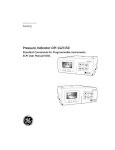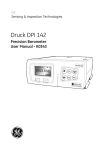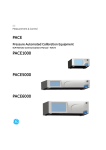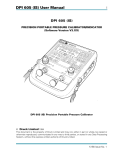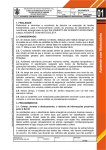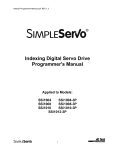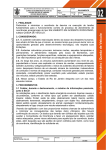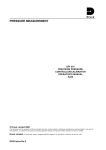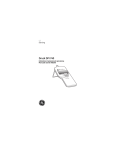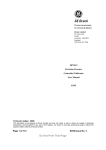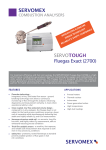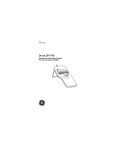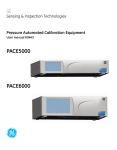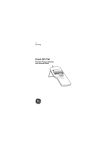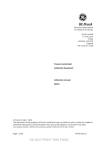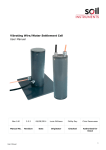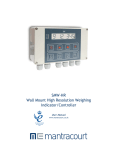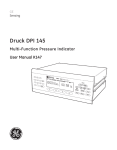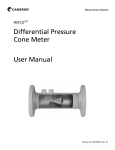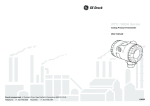Download gGE Druck - GE Measurement & Control
Transcript
g GE Druck Precision Pressure Controller/Calibrator DPI 515 SCPI User Manual K257 ©Druck Limited 2003 This document is the property of Druck Limited and may not be copied or otherwise reproduced, communicated in any way to third parties, nor stored in any Data Processing System without the express written authority of Druck Limited. Druck Limited, Fir Tree Lane, Groby, Leicester LE6 0FH, England. Tel: (0116) 231 7100 Fax: (0116) 231 7103 K257 Issue No. 2 K257 Issue No. 2 i Introduction This technical manual provides programming and communication instructions for the Druck DPI 515 Controller/Calibrator compatible with the requirements of a programming technician. Scope This technical manual contains the communications protocol for the operator of this equipment. Software This technical manual applies to software version 1. Safety The manufacturer has designed this product to be safe when operated using the procedures detailed in this manual. Do not use this product for any other purpose than that stated. This publication contains operating and safety instructions that must be followed to make sure of safe operation and to maintain the equipment in a safe condition. The safety instructions are either warnings or cautions issued to protect the user and the equipment from injury or damage. Use qualified* programming technicians and good engineering practice for all procedures in this publication. Pressure Do not apply pressure greater the maximum safe working pressure to the Druck DPI 515 Controller/Calibrator. Maintenance The Druck DPI 515 Controller/Calibrator must be maintained using the manufacturer’s procedures and should be carried out by authorised service agents or the manufacturer’s service departments. Technical Advice For technical advice contact the manufacturer or subsidiary. * A programming technician must have the necessary specialist knowledge of programming, technical knowledge and documentation to carry out the required work on the Druck DPI 515 Controller/Calibrator. Associated Druck Documents: K245 DPI 515 User Manual Associated Documents: A beginners Guide To SCPI by Barry Eppler, Published by Addison-Wesley Publishing Company Inc. for Hewlett Packard (ISBN 0-201-56350-9) K257 Issue No. 2 ii Table of Contents Preliminary pages Introduction ......................................................................................... i Safety ......................................................................................... i Table of contents (this table) ........................................................................................ ii List of Illustrations ......................................................................................... v List of Tables ......................................................................................... v Abbreviations ......................................................................................... vi Pressure measurement units ....................................................................................... vi Code Definitions ......................................................................................... vii Pressure unit conversions ......................................................................................... viii Section 1 2 2.1 2.2 2.3 2.4 3 3.1 3.2 3.3 3.4 3.5 3.6 4 4.1 page INTRODUCTION ......................................................................................... Remote/Local Operation ................................................................................... COMMAND SYNTAX ........................................................................................ Commands to the instrument ........................................................................... Command response from the instrument ......................................................... Program headers ......................................................................................... SCPI data types ......................................................................................... STATUS SYSTEM ......................................................................................... Output queue ......................................................................................... Standard event group ....................................................................................... Operation status group ..................................................................................... Status byte group ......................................................................................... Instrument errors ......................................................................................... Example program ......................................................................................... COMMAND AND QUERY SUMMARY ............................................................. Command structure ......................................................................................... CALibration ......................................................................................... :CAL:ZERO:AUTO ......................................................................................... :CAL:ZERO:AUTO:VAL .................................................................................... :CAL:ZERO:TIME ......................................................................................... :CAL:ZERO:TIME:STAT .................................................................................... INPut ......................................................................................... :INP:LOG ......................................................................................... INSTrument ......................................................................................... :INST:CAT ......................................................................................... :INST:LIM ......................................................................................... :INST:SN ......................................................................................... :INST:UNIT ......................................................................................... :INST:VERS ......................................................................................... OUTPut ......................................................................................... :OUTP:ISOL:STAT ......................................................................................... :OUTP:LOG:LEV ......................................................................................... :OUTP:STAT ......................................................................................... K257 Issue No. 2 1-1 1-2 2-1 2-1 2-3 2-4 2-5 3-1 3-3 3-4 3-5 3-7 3-10 3-11 4-1 4-1 4-5 4-5 4-6 4-7 4-8 4-9 4-9 4-10 4-10 4-11 4-12 4-13 4-14 4-15 4-15 4-16 4-17 iii Table of Contents (contd) Section 4.2 page SENSe ......................................................................................... :SENS:PRES ......................................................................................... :SENS:BAR ......................................................................................... :SENS:CORR:HEAD ......................................................................................... :SENS:CORR:HEAD:STAT ............................................................................... :SENS:CORR:HEAD:OFF ................................................................................. :SENS:CORR:HEAD:OFF:STAT ...................................................................... :SENS:FILT:STEP ......................................................................................... :SENS:FILT:FREQ ......................................................................................... :SENS:FILT:STAT ......................................................................................... :SENS:FILL:TIME ......................................................................................... :SENS:FILL:TIME:STAT .................................................................................... :SENS:RANG ......................................................................................... SOURce ......................................................................................... :SOUR:PRES:EFF ......................................................................................... :SOUR:PRES:INL ......................................................................................... :SOUR:PRES:INL:TIME .................................................................................... :SOUR:PRES:LEV:IMM:AMPL ......................................................................... :SOUR:VENT ......................................................................................... :SOUR:VENT:TIME ......................................................................................... :SOUR:RANG ......................................................................................... :SOUR:RANG:AUTO ......................................................................................... :SOUR:RANG:LOW ......................................................................................... :SOUR:SLEW ......................................................................................... :SOUR:SLEW:MODE ........................................................................................ :SOUR:SLEW:OVER ........................................................................................ STATus ......................................................................................... :STAT:OPER:COND ......................................................................................... :STAT:OPER:ENAB ......................................................................................... :STAT:OPER:EVEN ......................................................................................... :STAT:OPER:PRES:COND ............................................................................... :STAT:OPER:PRES:ENAB ............................................................................... :STAT:OPER:PRES:EVEN ............................................................................... SYSTem ......................................................................................... :SYST:ERR ......................................................................................... :SYST:VERS ......................................................................................... UNIT ......................................................................................... :UNIT:PRES ......................................................................................... UNIT:DEF ......................................................................................... * Standard commands ...................................................................................... *CLS ......................................................................................... *ESE ......................................................................................... *ESR ......................................................................................... :GTL ......................................................................................... *IDN? ......................................................................................... :LLO ......................................................................................... 4-18 4-18 4-19 4-20 4-21 4-22 4-23 4-24 4-25 4-26 4-27 4-28 4-29 4-30 4-30 4-31 4-32 4-33 4-34 4-35 4-36 4-37 4-38 4-39 4-40 4-41 4-42 4-42 4-43 4-44 4-45 4-46 4-47 4-48 4-49 4-50 4-51 4-52 4-53 4-54 4-54 4-55 4-56 4-57 4-58 4-59 K257 Issue No. 2 iv Table of Contents (contd) 5 5.1 6 6.1 7 Section page :LOC ......................................................................................... :REM ......................................................................................... *RST ......................................................................................... *SRE ......................................................................................... *STB? ......................................................................................... Aeronautical Command Reference ............................................................... Command structure ......................................................................................... SENSe ......................................................................................... SENS:ALT ......................................................................................... SENS:ALT:SLEW ......................................................................................... SENS:MACH ......................................................................................... SENS:MACH:SLEW ......................................................................................... SENS:SPE ......................................................................................... SENS:SPE:SLEW ......................................................................................... SOURce ......................................................................................... :SOUR:ALT ......................................................................................... :SOUR:ALT:SLEW ......................................................................................... :SOUR:MACH:IMM:AMPL ................................................................................. :SOUR:MACH:REF ......................................................................................... :SOUR:MACH:REF:MODE ............................................................................... :SOUR:MACH:REF:VAL ................................................................................... :SOUR:SPE ......................................................................................... :SOUR:SPE:SLEW ......................................................................................... UNIT ......................................................................................... UNIT:ALT ......................................................................................... UNIT:SPE ......................................................................................... Sensor Calibration Module Command Reference ...................................... Command structure ......................................................................................... SENSe ......................................................................................... SENS:SCM ......................................................................................... SENS:SCM:MODE ......................................................................................... CALibration ......................................................................................... CAL:SCM ......................................................................................... ERRORS ......................................................................................... 4-60 4-61 4-62 4-63 4-64 5-1 5-1 5-3 5-3 5-4 5-5 5-6 5-7 5-8 5-9 5-9 5-10 5-11 5-12 5-13 5-14 5-15 5-16 5-17 5-17 5-18 6-1 6-1 6-3 6-3 6-4 6-5 6-5 7-1 K257 Issue No. 2 v List of Illustrations Figure Figure Figure Figure Figure Figure Figure Figure Figure page 1-1 2-1 2-2 2-3 3-1 4-1 5-1 6-1 System Model ........................................................................................ General Command Syntax .................................................................... Command Syntax .................................................................................. Response Syntax ................................................................................... Status System ........................................................................................ Command and Query Summary ............................................................ Aeronautical Command and Query Summary ...................................... SCM Command and Query Summary ................................................... 1-1 2-1 2-2 2-3 3-2 4-2 5-2 6-2 List of Tables Table 3-1 3-2 3-3 7-1 7-2 7-3 7-3 page Standard Event Register ................................................................................... Operation Status Register ................................................................................ Status Byte Register ......................................................................................... Errors -100 to -199 ......................................................................................... Errors -200 to -299 ......................................................................................... Errors -300 to -400 ......................................................................................... Errors +201 to +212 ......................................................................................... 3-12 3-14 3-16 7-1 7-2 7-2 7-3 K257 Issue No. 2 vi Abbreviations The following abbreviations are used in this manual; abbreviations are the same in the singular and plural. abs ASCII ATE e.g. etc. Fig. ft g GPIB i.e. IEEE 488 m max mbar min No. qa RS232 SCM SCPI +ve -ve C F Absolute American Standard Code for Information Interchange Automatic test equipment For example And so on Figure Foot Gauge General purpose information bus That is Institute of Electrical and Electronic Engineers standard 488 data Metre Maximum Millibar Minute or minimum Number Quasi-absolute (combination of barometric and gauge sensor readings) Serial communications standard Sensor calibration module Standard commands for programmable instruments Positive Negative Degrees Celsius Degrees Fahrenheit Pressure measurement units The following units are used in this manual ATM atmosphere BAR bar CMH2O centimetres of water at 20 C CMHG centimetres of mercury FTH2O feet of water at 20 C FTH2O4 feet of water at 4 C HPA hecto Pascals INH2O inches of water at 20 C INH2O4 inches of water at 4 C INH2O60 inches of water at 60 F INHG inches of mercury KG/CM2 kilogrammes per square centimetre KG/M2 kilogrammes per square metre KPA kilo Pascals LB/FT2 pounds per square foot MH2O metres of water MHG metres of mercury MMH2O millimetres of water MMHG millimetres of mercury MPA mega Pascals PA Pascals PSI pounds per square inch TORR torr MBAR millibar K257 Issue No. 2 vii Code Definitions The following codes are used in this manual. CAL Calibration CAT Catalogue CLS Clear COND Condition CONF Configuration EAV Error in error queue ENAB Enable EOI End of input ERR Error ESB Summary bit from standard event EVEN Event GTL Go to local INL In limit INP Input INST Instrument ISOL Isolation LEV Level LLO Local lock out LOG Logical MAV Message available in output queue MEAS Measure MSS Summary bit after SRQ OPR Operation OUTP Output OSB Summary bit from standard operations status register PASS Passive PRES Preset PRES Pressure QUE Queue QUES Questionable RES Reset SENS Sense SOUR Source SRE Service request enable SRQ Service request STB Status register query STAT State SYST System UNIT Unit of pressure K257 Issue No. 2 viii Glossary Terminology The terminology used in this manual is specific and individual interpretation must not be introduced. The terms are defined as follows: Adjust To bring to a more satisfactory state; to manipulate controls, levers, linkages, etc. to return equipment from an out-of-tolerance condition to an in-tolerance condition. Align To bring into line; to line up; to bring into precise adjustment, correct relative position or coincidence. Assemble: To fit and secure together the several parts of; to make or form by combining parts. Calibrate: To determine accuracy, deviation or variation by special measurement or by comparison with a standard. Check: Make a comparison of a measure of time, pressure, temperature, resistance, dimension or other quality with a known figure for that measurement. Disconnect: To detach the connection between; to separate keyed or matched equipment parts. Dismantle: To take apart to the level of the next smaller unit or down to all removable parts. Examine: To perform a critical visual observation or check for specific conditions; to test the condition of. Fit: Correctly attach one item to another. Inspect: Review the work carried out by Specialists to ensure it has been performed satisfactorily. Install: To perform operations necessary to properly fit an equipment unit into the next larger assembly or system. Maintain: To hold or keep in any particular state or condition especially in a state of efficiency or validity. Operate: Make sure that an item or system functions correctly as far as possible without the use of test equipment or reference to measurement. Readjust: To adjust again; to move back to a specified condition; to bring back to an in-tolerance condition. K257 Issue No. 2 ix Reconnect: To rejoin or refasten that which has been separated. Refit: Fit an item which has previously been removed. Remove: To perform operations necessary to take an equipment unit out of the next larger assembly or system. To take off or eliminate. To take or move away. Repair: To restore damaged, worn out or malfunctioning equipment to a serviceable, usable or operable condition. Replace: Remove an item and fit a new or a serviced item. Reset: To put back into a desired position, adjustment or condition. Service: To perform such operations as cleaning, lubricating and replenishing to prepare for use. Test: Ascertain by using the appropriate test equipment that a component or system functions correctly. K257 Issue No. 2 x Pressure unit conversions Pressure unit Factor (Pascals) Pressure unit Factor (Pascals) bar 100000 lbf/ft2 47.8803 lbf/in2 (psi) 6894.76 inHg 3386.39 mH2O 9806.65 inH2O [1] 249.089 mbar 100 ftH2O [1] 2989.07 kgf/cm2 98066.5 atm kgf/m2 9.80665 pdl/ft2 101325.0 1.48816 2 mmHg 133.322 dyn/cm 0.1 cmHg 1333.22 hbar 10000000 mHg 133322.0 tonf/ft2 (UK) 107252.0 mm/H2O [1] 9.80665 tonf/in2 (UK) 15444300 cm/H2O [1] 98.0665 inH2O (USA) [2] 248.64135 N/m2 1 ftH2O (USA) [2] 2983.6983 hPa 100 kp/mm2 9806650 kPa 1000 kp/cm2 98066.5 MPa 1000000 kp/m2 9.80665 torr 133.322 Table of pressure units and conversion factors Unit Conversion To convert FROM pressure VALUE 1 in pressure UNITS 1 TO pressure VALUE 2 in pressure UNITS 2, calculate as follows: VALUE 2 = VALUE 1 x FACTOR 1 FACTOR 2 Note: The conversion factor for pressure units referenced [1] are calculated for a water temperature of 4°C. Pressure units referenced [2] are calculated for a water temperature of 68°F, these units are normally used in the USA. K257 Issue No. 2 Druck DPI 515 SCPI User Manual 1 INTRODUCTION 1.1 General 1-1 The IEEE 488 and RS232 interfaces of the DPI 515 Controller/Calibrator provide remote control of the instrument from a suitable computer or controller. The SCPI protocol enables any instrument with a SCPI facility to be controlled using the same commands. The DPI 515 Controller/Calibrator use the full SCPI command set and the defined SCPI syntax. The following sections describe and define each instrument command used by the DPI 515 Controller/Calibrator. The commands for the aeronautical option and the sensor calibration module option are described and defined in separate sections. Each section contains a quick reference structure of the relevant commands. logic Pressure in INPut sub-system CALibrate sub-system SYSTem sub-system SENSe sub-system UNITs sub-system STATus sub-system OUTPut sub-system SOURce sub-system INSTrument sub-system Pressure out logic Figure 1-1 System Model System Model SCPI starts with a high-level block diagram of the measurement functions of the instrument. Each functional block is broken down into smaller block diagrams. SCPI contains a hierarchy of commands called a subsystem that maps directly to the hierarchy of the block diagram. K257 Issue No. 2 1-2 1.2 Introduction Remote/Local Operation Any command received over the SCPI interface automatically puts the DPI 515 Controller/Calibrator into remote control mode and disables all front panel keys. Sending the IEEE 488 command GTL (Go To Local) returns the DPI 515 Controller/Calibrator to local control mode. Sending the IEEE 488 command LLO (Local Lock-out) locks the DPI 515 Controller/Calibrator in remote control mode until power-down. The DPI 515 Controller/Calibrator confirms remote control mode by displaying the message “Under Remote Control”. The display shows the full-scale value in the selected units of measurement and updates pressure readings. The parameters and units, used for the display, only change when the DPI 515 Controller/Calibrator receives a SOURce:PRESsure or UNIT:PRES command (new pressure or units). Any available parameters or units can be used over the SCPI interface. K257 Issue No. 2 Druck DPI 515 SCPI User Manual 2 2-1 COMMAND STRUCTURE This section describes the structure of the commands and data sent and received by the DPI 515 Controller/Calibrator. 2.1 Notation All SCPI commands are based on a hierarchical tree structure consisting of key words and parameters. Associated commands are grouped together under a common node in the hierachy. root Level 1 Level 2 A B E F G C D H J In the command tree the command A is the root command. A tree pointer is used to decode the SCPI commands. At power-up the pointer goes to the root command. 2.2 Message Terminators All SCPI commands are terminated by line feed i.e., either <newline> (ASCII character, decimal 10), EOI for IEEE. After receiving a termination character the tree pointer returns to the root command. Colon A colon moves the current path down one level in the command tree, (e.g., the colon in SOURCE:PRESSURE specifies PRESSURE the is one level below SOURCE). When the colon is the first character of the command, it specifies that the next command is a root level command (e.g., :SOURCE specifies that SOURCE is a root level command). K257 Issue No. 2 2-2 Command Syntax Semicolon A semicolon separates two commands in the same message without changing the tree pointer. (e.g., with reference to the tree) :A:B:E;F:G This equivalent to sending three messages :A:B:E :A:B:F :A:B:G Commas If a command requires more than one parameter, separate adjacent parameters by using a comma. A commas does not affect the tree pointer. (e.g.) :SYSTEM:TIME 10,25,30 To execute a command the full path to the command must be specified (e.g.) :OUTPut:STATe ON This turns the pressure controller on. Note: There must be a space between the command words and the parameter. In the above example there is a space between :STATe and ON. SCPI commands are not case sensitive and may have a short form. In this manual, upper case letter identify the short form. (e.g.) :OUTP is the short form of OUTPUT. Some nodes can be the default node and these key words are optional when programming the command. The instrument processes the command, with the same effect, with or without the option node. In this manual [] enclose [default notes]. (e.g.) :SOURce[:PRESsure:][:LEVel][:IMMediate][:AMPlitude] 5.0 can be sent as :SOURce:PRESsure:LEVel 5.0 or :SOURce 5.0 This sets the set-point to 5.0 K257 Issue No. 2 Druck DPI 515 SCPI User Manual 2.3 2-3 Program Headers Program headers are keywords that identify a command, instruments accept both upper and lower case characters in a program header. There are two types of program header, common command headers and instrument control headers; each header can be a command or a query. Common Command and Query Headers The common command and query program header syntax, specified in IEEE 488.2, are defined as follows: Command *<PROGRAM MNEMONIC> Query *<PROGRAM MNEMONIC>? Instrument Control Command and Query Headers The instrument control command and query program header syntax controls and extracts data from the instrument as follows: Command :<MNEMONIC> :<MNEMONIC> <PARAMETER> Query :<MNEMONIC>? Instrument command headers can have a numeric suffix to identify each of several cases of the same header; the numeric suffix applies to both the long and short forms. All commands headers without a numeric suffix assume the value 1. e.g., :OUTPut:LOGic1:LEVel? is the same as :OUTPut:LOGic:LEVel? Queries Most SCPI commands can be queried. A query is a command header with an attached question mark character (?). On receiving a query command, the current settings for the command are loaded in the output buffer. A query does not affect the operation or set-up of the instrument. When the parameter contains enumerated character data, both long form and short form are recognised. Querying the command causes the return of data in the short form. Querying numeric parameters causes the resulting data to be returned in the units selected by the instrument unless specified otherwise. K257 Issue No. 2 2-4 2.4 Command Syntax SCPI Data Types A variety of data types can be sent to the instrument as parameters or sent out from the instrument as response data. Decimal Numeric Data All normal decimal expressions are accepted including optional signs, decimal point and scientific notation. Note: This includes floating point data. The following are valid: 123 45.67 -2.6 4.6e-10 .76 A suffix multiplier can be added to the numeric value. :SOUR 100 m would set the programmable output to 0.1 units (100m units). The multipliers supported are: Mnemonic Multiplier A 1e-18 G 1e+9 K 1e+3 M 1e-3 T 1e+12 If a real value is sent to the instrument when an integer is expected, it will be rounded to an integer. Integer Data Integer data are whole numbers (containing no decimal places). A query of an integer value returns numbers containing no decimal places. Note: Integer values can be specified in binary, octal or hexadecimal formats using the suffix letters (upper or lower case) B, Q and H respectively. e.g., #B1010 binary representation of 10 #Q71 octal representation of 57 #HFA hexadecimal representation of 250 Hexadecimal digits A-F can be in upper or lower case. K257 Issue No. 2 Druck DPI 515 SCPI User Manual 2-5 Enumerated Character Program Data Enumerated characters are used for data that has a finite number of values; enumerated parameters use mnemonics to represent each valid setting. The mnemonics have long and short forms just like command mnemonics. Example: :SOURce:PRESsure:SLEW:MODE MAXimum selects the maximum rate mode. A query of an enumerated parameter always returns the short form data in upper case. Example: :SOURce:PRESsure:SLEW:MODE? queries rate mode, reply: MAX Boolean Program Data Boolean data can only be one of two conditions; the numbers 1 and 0. Example: :OUTPut:STATe 1 A query of boolean data always returns 1 or 0. String Data String data can contain any of the ASCII characters. A string must start with a double "quote" (ASCII 34) or a single `quote` (ASCII 39) and end with the same character. Example: :SOURCe[:PRESsure]:RANGe ‘2barg’ or :SOURCe[:PRESsure]:RANGe “2barg” selects the 2 bar g range. A query of a string parameter always returns the string in double "quotes". K257 Issue No. 2 2-6 Command Syntax Intentionally left blank K257 Issue No. 2 Druck DPI 515 SCPI User Manual 3 3-1 STATUS SYSTEM The status reporting system informs the external controller that an event has occurred. This information is in the form of a service request (SRQ) using IEEE 488 or an SRQ message using RS232. The DPI 515 instrument uses status reporting as defined in IEEE 488.2 with the implementation of status registers. The OPERation and QUEStionable status registers have been implemented To comply with the SCPI protocol. These are registers where the individual bits are summary bits of the status of the instrument. Since the SCPI protocol does not include pressure instruments, bit 10 of both these registers are used as a pressure summary bit. This pressure summary bit is expanded to two, 16 bit registers (Bit 15 is not used and is always zero). The Questionable and Pressure Questionable registers are not used. The only bit implemented in the Operation status register is bit 10 (summary of the pressure operation status). A summary bit is the final output of a data structure, it is a single bit that shows the status of one or more related events in the instrument. The basic structure of a summary bit Condition register Event register Enable register Logical ANDing of the Event and Enable registers Summary bit that summarises the result using OR logic Condition Register This register shows the current status of the device. The condition register is constantly updated - the bits in the register are set or reset showing the current condition. Event Register The event register shows an event that occurs in the condition register (a condition bit goes from low to high). This condition change is stored and only reset when the event register is read or the *CLS command sent. Enable Register This register allows the results of the event register to pass through to the next cascaded register and enables the user to select the event that should generate the final SRQ event. K257 Issue No. 2 3-2 Status System The status system implemented in the instrument is shown in the following diagram: Note: Key: C = EV = EN = Initial values of registers are 0, with the queues empty. Condition - variable values Latched values Bit mask Figure 3-1 Status System K257 Issue No. 2 Druck DPI 515 SCPI User Manual 3.1 3-3 Output queue The output queue is a text readable data queue that is read through the IEEE 488 talk command. The queue is cleared by reading all elements in it or by the *CLS command. Every time a query has been successfully completed, the response, in a text readable format is placed at the end of the output queue. If the MAV bit in the "Status Byte" was previously cleared it will be set. The output queue can contain up to 256 characters. If there is not enough space in the output queue for a new message, the error -350, "Queue overflow" will be placed into the error queue and the most recent output message will be lost. K257 Issue No. 2 3-4 3.2 Status System Standard event group The standard event group are 8 bit registers that are read by the IEEE 488 standard commands. The event register is cleared by reading it; the event and enable registers are cleared by the *CLS command. Bits within the standard event condition register are set by system errors and events. In addition to setting the status bits, a text message will be placed in the error queue. The ESB bit in the status byte sets if the associated bit in the event enable register is set. The enable register may be set through the *ESE command so that selected standard events cause the ESB bit to be set. The system events that set each bit are as follows: Bit Name Description Meaning/data 0 OPC Not used Reserved currently returns 0 1 RQC Not used Reserved currently returns 0 2 QYE -400 to -499 Query errors 3 DDE Not used Reserved currently returns 0 4 EXE -200 to -299 Execution errors 5 CME -100 to -199 Command errors 6 URQ Not used Reserved currently returns 0 7 PON Not used Reserved currently returns 0 Table 3-1 Standard Event Register K257 Issue No. 2 Druck DPI 515 SCPI User Manual 3.3 3-5 Operation status group The operation status group are 16 bit registers that are read by the STAT:OPER commands. The event register is cleared by reading it; the event and enable registers are cleared by the *CLS command. When a standard operation condition occurs an appropriate bit is set in the condition register (this clears when the condition no longer exists). The bit is then latched in the event register. If the associated bit in the enable register is set, the OPR bit in the status byte sets. The enable register may be set through the STAT:OPER:ENAB command so that only selected standard operation events cause the OPR bit to set. Problems can occur with some IEEE 488 controllers reading 16 bit unsigned numbers. All registers in this group do not use bit 15. The enable bit cannot be set and when read returns 0. The condition register is defined as follows: Vent complete This signal occurs when the controller has been requested to vent and the vent has completed or timed out. Range change complete This signal occurs when the controller has been requested to perform a range change and the range change is complete. In-Limits reached This signal is set every time the controlled pressure is within the specified limits. The signal is only generated if the pressure has been within limits for a user defined wait time period. Zero complete This signal is generated when a manual or timed zero is complete. If the zero times out then this signal is also generated. K257 Issue No. 2 3-6 Status System Bit (1) Data (2) Bit (3) Data (4) 0 Vent complete 1 Range change complete 2 In-limits reached 3 Zero complete 4 Auto-zero started 5 Fill time, timed-out 6 Reserved - returns 0 7 Reserved - returns 0 8 Switch contacts changed state 9 Reserved - returns 0 10 Reserved - returns 0 11 Reserved - returns 0 12 Reserved - returns 0 13 Reserved - returns 0 14 Reserved - returns 0 15 Reserved - returns 0 Table 3-2 Operation Status Register Auto zero started When the controller is in the auto zero mode this signal indicates that the auto zero process has started. Thezero complete signal indicates that the zero process has finished. Fill timed out If a set-point has been requested and the set-point cannot be achieved within the fill timeout time, the fill timed out signal is generated. Switch contacts changed state Every time the switch contacts used for performing a switch test change state this bit is set. K257 Issue No. 2 Druck DPI 515 SCPI User Manual 3.4 3-7 Status Byte group The status byte group are 8 bit registers that are read by the IEEE 488 standard commands. The event register is cleared by reading it; the event and enable registers are cleared by the *CLS command. Bits within the status byte are a summary of other data structures in the status system. These bits will become set if other parts of the status system indicates that they should do so (i.e., a message in the output queue or error queue or, a condition and enable set in a register pair). If the associated bit in the status enable register is set, a serial poll is generated and bit 6 is set. The enable register may be set through the *SRE command so that only selected status bits cause a serial poll. Note: Bit 6 of the enable register is always set to 0. There are some small differences between * STB? and serial polling. Either method can be used to read the state of bits 0-5 and bit 7. The reading method is different for bit 6 when using *STB? and serial poll. In general, use serial polling inside interrupt service routines, not *STB? Bit 2 - EAV sets when there is an error in the error queue. The :SYST:ERR? command has to be sent to retrieve the error. The error queue buffers a maximum of five errors. When no more errors are available the message “No Error” is returned. Bit 4 - MAV sets when there is a message available in the output queue. K257 Issue No. 2 3-8 Status System Bit 5 - ESB sets when a standard event has occurred in the Standard Event Register. Bit 6 - MSS sets when an SRQ is generated - SRQ sets when both the Status byte and the Service Request Enable register are at logic 1 (AND function). RS232 Specific A service request (SRQ) produces the message: :SRQ <value> where: <value> = the contents of the status summary byte. The status system data structure sets each bit as follows: Bit Name Description 0 - Reserved currently returns 0 1 - Reserved currently returns 0 2 EAV 3 - 4 MAV Messages available in output queue 5 ESB Summary bit from standard event 6 MSS Summary bit after service request - SRQ 7 OSB Summary bit from standard operations status Error in error queue Reserved currently returns 0 Table 3-3 Status Byte Register Example commands using the Status Byte and Status Byte Enable registers: *SRE 16 Generate an SRQ interrupt when messages are available. *SRE? Find out what events are enabled to generate SRQ interrupts. *STB? Read and clear the Status Byte Event register. IEEE 488 Specific Bit 7 - OSB sets when the pressure operations register bit 10 changes state. The operations register is a 16 bit register only using bit 10. This bit is a summary of the pressure operations register. K257 Issue No. 2 Druck DPI 515 SCPI User Manual 3-9 Status reporting register structure To set-up the status reporting system. 1 All status registers should be cleared by the command: *CLS 2 The Pressure Operations Event register has to be set to enable the Pressure Operations Condition Register to send all the events to be reported; use the command: :STAT:OPER:PRES:ENAB 511 The enabled events may also be read by the query: :STAT:OPER:PRES:ENAB? 3 The Operation Status Event register must then be enabled to read bit 10 by the command: :STAT:OPER:ENAB 1024 The enabled events may also be read by the query: :STAT:OPER:ENAB? 4 The status request to enable the SRQ must then be set. To enable only the Operation Status register (OSB) send the command: *SRE 128 To enable the Operation Status register (OSB) and the Error Queue (EAV) send the command: *SRE 132 This register may also be read by the query: *SRE? An event occurring generates an SRQ, the Status Byte should be queried to find the source of the event. K257 Issue No. 2 3 - 10 Status System If bit 2 of the Status Byte Register is set the error queue can be read by the query: :SYST:ERR? Keep issuing this query until there are no more errors in the error queue. At this point, bit 2 of the Status Byte Register clears. If bit 7 of the Status Byte Register is set the Pressure Operations event register can be read by the query: :STAT:OPER:PRES? returning the bits of events that have occurred. Reading this register clears it and the associated status bit (bit 7). At any time the instantaneous status of the pressure system can be read by the query: :STAT:OPER:PRES:COND? 3.5 Instrument Errors Any instrument error that occurs, either programming errors or execution errors, is stored in an error queue which is separate from the main output queue. The errors can be read by issuing the following command query: :SYST:ERR? The error queue can hold up to five errors. Each time the error queue is queried the instrument responds with the next stored error in the queue. The response consists of an error number followed by a string describing the error. When the error queue is empty the instrument responds with: 0,”No error” Querying the error queue clears the storage location in the error buffer. If more than five errors occur, before being queried, the ‘Queue overflow;Error queue overflow’ message is placed into the error queue. All subsequent errors are lost until the error queue is cleared. K257 Issue No. 2 Druck DPI 515 SCPI User Manual 3.6 3 - 11 Example program The following program example is written in QUICK BASIC and illustrates the use of various commands and responses. Program Overview Initializes the IEEE 488 interface. Gets instrument identity. Gets pressure ranges fitted Sets units as mbar and queries units. Enters rate of change as maximum rate and queries rate mode. Enters 1000 mbar set-point and queries set-point. Sets controller on and queries controller state. Queries pressure reading time/date (keys a and b changes the query parameter). Print pressure reading or time/date. Print time and date. Wait 1 second. Goes round loop until q key is pressed. Sets controller off. Queries controller state. See www.DPI515.com/downloads for more examples K257 Issue No. 2 3 - 12 Status System Example program OPEN "IEEECTRL" FOR RANDOM AS #1 OPEN "IEEEDATA" FOR RANDOM AS #2 IOCTL #1, "4" PRINT IOCTL$(1) 'check device address IOCTL #2, "*IDN?" + CHR$(10) PRINT IOCTL$(2) ' send query instrument type ' read reply of instrument type IOCTL #2, ":INST:CAT?" + CHR$(10) PRINT IOCTL$(2) ' send query ranges fitted ' read reply of ranges fitted IOCTL #2, ":UNIT MBAR" + CHR$(10) IOCTL #2, ":UNIT?" + CHR$(10) PRINT IOCTL$(2) ' select mbar units ' send units query ' read reply of units query IOCTL #2, ":SOUR:SLEW:MODE MAX" + CHR$(10) ' select max rate IOCTL #2, ":SOUR:SLEW:MODE?" + CHR$(10) ' send rate mode query PRINT IOCTL$(2) ' read reply of rate mode query IOCTL #2, ":SOUR 1000.0" + CHR$(10) IOCTL #2, ":SOUR?" + CHR$(10) PRINT IOCTL$(2) IOCTL #2, ":OUTP 1" + CHR$(10) IOCTL #2, ":OUTP?" + CHR$(10) PRINT IOCTL$(2) A$ = ":sens?" + CHR$(10) ' setpoint of 1000 mbar ' send setpoint query ' read reply of setpoint query ' turn controller on ' send controller state query ' read reply of controller state query ' data to query pressure DO IF INKEY$ = "a" THEN A$ = ":sens?" + CHR$(10) ' query pressure IF INKEY$ = "b" THEN A$ = ":syst:time?;date?" + CHR$(10) ' query time and date" IOCTL #2, A$ PRINT IOCTL$(2) ' read the device SLEEP 1 ' wait for 1 second LOOP WHILE INKEY$ <> "q" IOCTL #2, ":OUTP 0" + CHR$(10) IOCTL #2, ":OUTP?" + CHR$(10) PRINT IOCTL$(2) CLOSE #1: CLOSE #2 END K257 Issue No. 2 ' turn controller off ' send controller state query ' read reply of controller state query Druck DPI 515 SCPI User Manual 4 4-1 COMMAND AND QUERY SUMMARY The following lists of all the SCPI commands and queries that apply to the instrument. 4.1 Command structure Some of the commands in the following summary are enabled at specific times and conditions, most can be enabled at any time. The parameters column shows the states, values and data contained in a command. The command structure divides into subsystems as follows: Command sub-system :CALibration - calibration commands. :INPut - reads the logical input. :INSTrument - instrument specific commands. :OUTPut - controls the output pressure and logical outputs. :SENSe - directs the instrument to measure selected parameters. :SOURce - covers the commands that control the pressure outputs. . :STATus - instruments state. :SYSTem - errors and SCPI version. :UNIT - sets the units for the instrument. K257 Issue No. 2 4-2 Command and Query Summary Command Parameters CALibration :[PRESSure] :ZERO :AUTO :AUTO? :VALue Comments zero offset <Boolean> <number> <integer> <Boolean> :TIME :STATe INPut :LOGic [:STATe]? on/off offset value of absolute range enabled/disabled timed zero reads logical input INSTrument :CATalog [:LIMits]? :SN UNIT? :VERSion? lists ranges and details of transducers fitted OUTPut :ISOLation [:STATe] :STATe? :LOGic :LEVel :LEVel? [:STATe] [:STATe]? Turns pressure controller on/off, controls isolation valves and logical outputs. <Boolean> <Boolean> <Boolean> :SENSe [:PRESsure]? BARometer? :CORRection :HEAD :HEAD? :STATe :STATe? :OFFset :OFFset? :STATe :STATe? configures measurement functions, height difference adjustment. Air or nitrogen. <enumerated>,<numeric> <Boolean> <number> continued ... Figure 4-1 Command and Query Summary K257 Issue No. 2 Druck DPI 515 SCPI User Manual Command Parameters :FILTer [:LPASs] :STEP :STEP? :FREQuency :FREQuency? [:STATe] [:STATe]? :FILL :TIME :TIME? :STATe :STATe? :RANGe :RANGe? SOURce [:PRESsure] :EFFort? :INLimits :INLimits? :TIME :TIME? [:LEVel] [:IMMediate] [:AMPlitude] :VENT :VENT? :TIME :TIME? :RANGe :RANGe? :LOW? :SLEW :SLEW? :MODE :MODE? :OVERshoot [:STATe] [:STATe]? 4-3 Comments <number> <number> low pass filter filter step response <number> filter averaging value <Boolean> on/off time in seconds <integer> <Boolean> on/off <string> sensor range <string> pressure output details <number> <number> time in seconds <number> vents the user system <number> <string> controller range information <number> rate in pressure units/ second <enumerated> <Boolean> continued ... Figure 4-1 Command and Query Summary K257 Issue No. 2 4-4 Command and Query Summary Command Parameters :STATus :OPERation :CONDition? :ENABle :ENABLe? [:EVENt]? :PRESsure :CONDition? :ENABle :ENABLe? [:EVENt]? status register information <integer> <integer> :SYSTem :ERROr? :VERSion? :UNIT [:PRESsure] [:PRESsure]? :DEFine :DEFine? *CLS *ESE *ESE? *ESR? *GTL *IDN? *LLO *LOC *REM *RST *SRE *SRE? *STB? Comments error queue SCPI version <name> <string>,<number> ASCII (unit name) conversion factor standard SCPI commands <integer> <integer> Figure 4-1 Command and Query Summary K257 Issue No. 2 Druck DPI 515 SCPI User Manual 4-5 CALibration The CALibration subsystem enables the calibration of the transducers and the rate control system, refer to the user manual for further details. :CAL:ZERO:AUTO Command Syntax :CALibration:ZERO:AUTO <Boolean> Parameter: Boolean Short form: Function: Default: 0 1 - aborts the zero performs a zero :CAL:ZERO:AUTO Pressure zeroing 0 Query Syntax :CALibration:ZERO:AUTO? Short form: Function: Response: :CAL:ZERO:AUTO? Query progress of zero 0 - Zero OK 1 - Zero in progress 2 - Zero timed out 3 - Zero offset outside limits 4 - Zero aborted Description This command is used to zero the currently selected sensor and starts a zero sequence. The progress of the zero can be monitored by using the query for this command. A parameter of zero aborts this command function (zero sequence). K257 Issue No. 2 4-6 Command Reference :CAL:ZERO:AUTO:VAL Command Syntax :CALibration:ZERO:AUTO:VALue <number> Parameter: number applied pressure Short form: Function: Defaults: :CAL:ZERO:AUTO:VAL Absolute sensor zeroing 0.0 minimum N/A maximum N/A Query Syntax :CALibration:ZERO:AUTO:VALue? Short form: Function: Response: :CAL:ZERO:AUTO:VAL? Ask applied value Number corresponding to applied pressure in the currently selected units. Description For absolute sensors a pressure of 0 is very difficult to achieve to perform the zero. Therefore to zero the absolute sensor a near vacuum is applied and measured. This command sets the measured pressure so that a single point compensation can be applied to the reading. K257 Issue No. 2 Druck DPI 515 SCPI User Manual 4-7 :CAL:ZERO:TIME Command Syntax :CALibration:ZERO:TIME <integer> Parameter: integer timed zero time in hours Short form: Function: Defaults: :CAL:ZERO:TIME Timed zero time. 24 minimum 1 maximum 999 Query Syntax :CALibration:ZERO:TIME? Short form: Function: Response: :CAL:ZERO:TIME? Timed zero time-out in hours Integer value for the timed zero time-out in hours Description The timed zero function allows the instrument to perform periodic zeroes on gauge ranges. The zero is performed when the timed zero time-out period has expired and a set-point of 0 is entered. K257 Issue No. 2 4-8 Command Reference :CAL:ZERO:TIME:STAT Command Syntax :CALibration:ZERO:TIME:STATe <Boolean> Parameter Boolean 0 1 - disable timed zero enable timed zero Short form: Function: Default: :CAL:ZERO:TIME:STATe <Boolean> Timed zero state OFF Query Syntax :CALibration:ZERO:TIME:STATe? Short form: Function: Response: :CAL:ZERO:TIME:STAT? Query state (on or off) of timed zero 1 (on) 0 (off) Description This command is used to enable or disable the timed zero function. K257 Issue No. 2 Druck DPI 515 SCPI User Manual 4-9 INPut The INPut subsystem obtains information about the input signal of the instrument. This subsystem contains query only command to get the state of the logical input used for switch testing. :INP:LOG Command Syntax n/a Parameter: Short form: Function: Default: Query Syntax :INPut:LOGic[:STATe]? Short form: Function: Response: :INP:LOG? Reads the logic input state 1 (logic 1) 0 (logic 0) Description This query only command is used to read the state of the logical input. K257 Issue No. 2 4 - 10 Command Reference INSTrument The INSTrument subsystem gets information about the configuration of the instrument and contains query only commands. :INST:CAT Command Syntax n/a Parameter: Short form: Function: Query Syntax :INSTrument:CATalog? Short form: Function: Response: :INST:CAT? Query ranges fitted A list of comma separated strings of ranges fitted. Description This command returns a list of ranges fitted to the instrument. The reply is a comma separated list of strings representing each range. e.g. “2barg”,”3.5barqa”. If a barometer is fitted, the string “BAROMETER” is added to the list. K257 Issue No. 2 Druck DPI 515 SCPI User Manual 4 - 11 :INST:LIM Command Syntax n/a Parameter: Short form: Function: Query Syntax :INSTrument:[LIMits][x]? Short form: Function: Response: :INST? Queries the upper and lower full-scale limits of the fitted ranges. The index number x is used to index into the list of available ranges. A string representing the range, a number representing the upper full-scale and a number representing the lower full-scale. Description This query only command return the name of the range as a string and the upper and lower pressure limits in the selected units. e.g. :INST3? “2barg”, 2.0, -1.0 K257 Issue No. 2 4 - 12 Command Reference :INST:SN Command Syntax n/a Parameter: Short form: Function: Query Syntax :INStrument:SN? Short form: Function: Response: :INST:SN? Used to query the serial number of the instrument. Asks for serial number Integer representing serial number Description This query only command returns the serial number of the instrument. K257 Issue No. 2 Druck DPI 515 SCPI User Manual 4 - 13 :INST:UNIT Command Syntax n/a Parameter: Short form: Function: Query Syntax :INSTrument:UNIT[x]? Short form: Function: Response: :INST:UNIT? Queries the available units. The number x is the index into the units. Enumerated type of the unit. ATM BAR CMH2O CMHG FTH2O FTH2O4 HPA INH2O INH2O4 INH2O60 INHG KG/CM2 KG/M2 KPA LB/FT2 MH2O MHG MMH2O MMHG MPA PA PSI TORR MBAR USER1 USER2 NONE Description This command is used to query the available units of pressure measurement in the instrument. The units list depends on the area of use configuration. If a index number is specified which does not contain a unit then NONE is returned. K257 Issue No. 2 4 - 14 Command Reference :INST:VERS Command Syntax n/a Parameter: Short form: Function: Query Syntax :INSTrument:VERSion? Short form: Function: Response: :INST:VERS? Queries the software versions of the controller. Returns three strings representing the version numbers of the main controller code, CAN controller and BOOT code. Description The main controller code is the part that can be upgraded through the code update utility. The CAN and BOOT code is stored in EEPROM and can only be replaced by replacing the EEPROM. K257 Issue No. 2 Druck DPI 515 SCPI User Manual 4 - 15 OUTPut The OUTPut subsystem turns the pressure controller on/off, controls the state of the isolation valves and the state of the logical outputs. :OUTP:ISOL:STAT Command Syntax :OUTPut:ISOLation[:STATe] <Boolean> Parameter: Boolean 0 1 - close open Short form: Function: Default: :OUTP:ISOL Isolation valve state OFF - isolation valve closed Query Syntax :OUTPut:ISOLation:STATe? Query Short form: Function: Response: :STATe? :OUTP:ISOL? Queries state of isolation valve 1 (open) 0 (closed) Description Opens/Closes the isolation valve of the current range. K257 Issue No. 2 4 - 16 Command Reference :OUTP:LOG:LEV Command Syntax :OUTPut:LOGic[x]:LEVel <Boolean> Parameter: Boolean Short form: Function: :OUTP:LOG[x]:LEV Controls the level of the digital outputs. The index number x specifies the output line. 1 for output 1 and 2 for output 2. 0 Default: 0 1 - level low level high Query Syntax :OUTPut:LOGic[x]:LEVel? Short form: Function: Response: :OUTP:LOG[x]:LEV? Asks for level of output line 0 - level low 1 - level high Description The instrument has two digital output lines, the levels on these lines are controlled using this command. K257 Issue No. 2 Druck DPI 515 SCPI User Manual 4 - 17 :OUTP:STAT Command Syntax :OUTPut:STATe <Boolean> Parameter: Boolean 0 1 - turn controller off turns controller on Short form: Function: Default: :OUTP Turn the pressure controller on/off 0 Query Syntax :OUTPut:STATe? Short form: Function: Response: :OUTP? Asks for state of pressure controller 0 - controller off 1 - controller on Description Sets or queries the state of the pressure controller. K257 Issue No. 2 4 - 18 Command Reference SENSe The SENSe subsystem selects and configures the measurement functions of the instrument. :SENS:PRES Command Syntax n/a Parameter: Short form: Function: Query Syntax :SENSe[:PRESsure]? Short form: Function: Response: :SENS? This query only command reads the sensor which has been selected by the RANGE command. A pressure reading in the current units. Description Queries the pressure reading for the selected sensor in the selected units. The sensor can be changed see, :SENSe[:PRESsure]:RANGe and :SOURe[:PRESsure]:RANGe commands. Issuing the SOURce command can also change the range. K257 Issue No. 2 Druck DPI 515 SCPI User Manual 4 - 19 :SENS:BAR Command Syntax n/a Parameter: Short form: Function: Query Syntax :SENSe[:PRESsure]:BARometer? Short form: Function: Response: :SENS:BAR? Queries the barometric pressure value. <number> in the selected units of pressure measurement. Description Returns the barometric pressure measured by the optional barometric transducer. If the optional barometric transducer is not fitted the response is zero pressure. K257 Issue No. 2 4 - 20 Command Reference :SENS:CORR:HEAD Command Syntax :SENSe[:PRESsure]:CORRection:HEAD <enumerated>,<numeric> Parameters: enumerated numeric Short form: Function: Default: AIR - Air used as gas NITRogen - Nitrogen used as gas Height of gas in cm. :SENS:CORR:HEAD <enumerated>,<numeric> Head correction parameters Enumerated AIR numeric 0 Minimum numeric -1e10 cm Maximum numeric 1e10 cm Query Syntax :SENSe[:PRESsure]:CORRection:HEAD? Short form: Function: Response: :SENS:CORR:HEAD? Query gas and height of head correction AIR/NITRogen and height in cm Description A correction must be made if the unit under test is at a different height from the instrument. This command programs the gas used and the height difference. K257 Issue No. 2 Druck DPI 515 SCPI User Manual 4 - 21 :SENS:CORR:HEAD:STAT Command Syntax :SENSe[:PRESsure]:CORRection:HEAD:STATe <Boolean> Parameter Boolean 0 1 - Disables head correction Enables head correction Short form: Function: Default: :SENS:CORR:HEAD:STAT <Boolean> Enables / disables head correction. 0 Query Syntax :SENSe[:PRESsure]:CORRection:HEAD:STATe? Short form: Function: Response: :SENS:CORR:HEAD:STAT? Query head correction state 0 - head correction off 1 - head correction on Description This command enables or disables the head correction compensation. K257 Issue No. 2 4 - 22 Command Reference :SENS:CORR:HEAD:OFF Command Syntax :SENSe[:PRESsure]:CORRection:HEAD:OFFset Parameter: Short form: Function: Default: <number> tare offset value :SENS:OFF Subtracts the offset value from the processed reading. 0 Minimum numeric -1e10 cm Maximum numeric 1e10 cm Query Syntax :SENSe[:PRESsure]:CORRection:HEAD:OFFset? Short form: Function: Response: :SENS:OFF? Asks for the tare value. Number corresponding to the tare offset value. Description This command must be enabled by SENS:OFF:STAT and sets up the offset value. K257 Issue No. 2 Druck DPI 515 SCPI User Manual 4 - 23 :SENS:CORR:HEAD:OFF:STAT Command Syntax :SENSe[:PRESsure]:CORRection:HEAD:OFFset:STATe Parameter: Short form: Function: <Boolean> 0 disables tare offset 1 enables tare offset :SENS:OFF:STAT Enables and disables the tare offset function. Query Syntax :SENSe[:PRESsure]:CORRection:HEAD:OFFset:STATe? Short form: Function: Response: :SENS:OFF:STAT? Asks if tare offset function is on or off. 1 (on) 0 (off) Description This command enables SENS:OFF to be used to set-up the offset value. K257 Issue No. 2 4 - 24 Command Reference :SENS:FILT:STEP Command Syntax :SENSe[:PRESsure]:FILTer:[LPASs]:STEP <number> Parameter: number filter step response value Short form: Function: Default: :SENS:FILT:STEP Used to set-up the step response band component of the filter. 0 minimum 0 maximum 100.0 Query Syntax :SENSe[:PRESsure]:FILTer:[LPASs]:STEP? Query Short form: Function: Response: :STEP? :SENS:FILT:STEP? Ask for filter step response band parameter. Number corresponding to filter step response value. Description The digital low pass filter has a step response band configured as percentage of fullscale. e.g., defaults to 0.05 %FS. If the reading has changed by more than the configured step response value then the filtering is ignored for that conversion and the pressure goes instantly to the new value. K257 Issue No. 2 Druck DPI 515 SCPI User Manual 4 - 25 :SENS:FILT:FREQ Command Syntax :SENSe[:PRESsure]:FILTer:[LPASs]:FREQuency <number> Parameter: number filter averaging value Short form: Function: Default: :SENS:FILT:FREQ Used to set up the averaging component of the filter. 0 minimum 0 maximum 20 Query Syntax :SENSe[:PRESsure]:FILTer:[LPASs]:FREQuency? Short form: Function: Response: :SENS:FILT:FREQ? Ask for filter average parameter. Number corresponding to filter average value. Description A digital low pass filter can be applied to the pressure reading. This is a first order low pass filter, the time constant depends on the value set by this command. K257 Issue No. 2 4 - 26 Command Reference :SENS:FILT:STAT Command Syntax :SENSe[:PRESsure]:FILTer[:LPASs]:STATE <Boolean> Parameter: Boolean 0 1 - Disables low pass filter Enables low pass filter Short form: Function: Default: :SENS:FILT <Boolean> Sets low pass filter ON or OFF. OFF Query Syntax :SENSe[:PRESsure]:FILTer[:LPASs]:STATe? Short form: Function: Response: :SENS:FILT? Query state (on or off) for the low pass filter 1 (ON) 0 (OFF) Description This command is used to enable or disable the low pass filter for producing a more stable reading. An ‘intelligent’ filter is implemented so that any noise in the system is filtered while step changes pass straight though the filter. K257 Issue No. 2 Druck DPI 515 SCPI User Manual 4 - 27 :SENS:FILL:TIME Command Syntax :SENSe[:PRESsure]:FILL:TIME <integer> Parameter: integer fill time in seconds Short form: Function: Default: :SENS:FILL:TIME Sets the fill time, time-out period. 20 seconds minimum 20 seconds maximum 999 seconds Query Syntax :SENSe[:PRESsure]:FILL:TIME? Short form: Function: Response: :SENS:FILL:TIME? Asks for fill time, time-out period. Integer corresponding fill time, time-out period in seconds Description If fill time, time-out settings are enabled, then the controller automatically switches to measure mode if the controller cannot achieve the set-point within the specified time-out setting. K257 Issue No. 2 4 - 28 Command Reference :SENS:FILL:TIME:STAT Command Syntax :SENSe[:PRESsure]:FILL:TIME:STATe <Boolean> Parameter: Boolean 0 1 - fill time-out disabled fill time-out enabled Short form: Function: Default: :SENS:FILL:TIME:STAT Enables / disables the time-outs. OFF Query Syntax STATe? Short form: Function: Response: :SENS:FILL:TIME:STAT? Asks if fill time, time-outs are enabled or disabled. 0 - fill time, time-out disabled 1 - fill time, time-out enabled Description If fill time, time-out settings are enabled, then the controller automatically switches to measure mode if the controller cannot achieve the set-point within the specified time-out setting. K257 Issue No. 2 Druck DPI 515 SCPI User Manual 4 - 29 :SENS:RANG Command Syntax :SENSe[:PRESsure]:RANGe <string> Parameter: Short form: Function: string range information :SENS:RANG Used to select a range to be sensed. Query Syntax :SENSe[:PRESsure]:RANGe? Short form: Function: Response: :SENS:RANG? Asks for currently sensed range. String representing selected pressure range. Description This command selects the pressure range to be used for returning the pressure reading, also see the SOURCe:RANGe command. Changing the source range also changes the sense range. e.g. :SENSe:RANGe “2barg” selects the 2 bar gauge range. K257 Issue No. 2 4 - 30 Command Reference SOURce The SOURce subsystem controls the pressure output of the instrument. :SOUR:PRES:EFF Command Syntax n/a Parameter: Short form: Function: Query Syntax :SOURce[:PRESsure]:EFFort? Short form: Function: Response: :SOUR:EFF? This query only command returns the effort the controller does to achieve the set-point. number representing controller effort. Description This query only command returns the effort the controller does to achieve the set-point. K257 Issue No. 2 Druck DPI 515 SCPI User Manual 4 - 31 :SOUR:INL Command Syntax :SOURce[:PRESsure]:INLimits <number> Parameter: number in limits value as %full-scale Short form: Function: :SOUR:INL <number> The controller has an in-limits set-point indicator. This can generate a service request when the pressure is within limits for a set time period. Default: 0.01 %FS minimum maximum 0 % FS 100 % FS Query Syntax :SOURce[:PRESsure]:INLimits? Short form: Function: Response: :SOUR:INL? Query in-limits value Number representing in-limits value as %FS. Description Sets the in-limits value. K257 Issue No. 2 4 - 32 Command Reference :SOUR:PRES:INL:TIME Command Syntax :SOURce[:PRESsure]:INLimits:TIME <number> Parameter: number in-limits time in seconds Short form: Function: :SOUR:INL:TIME <number> Sets the time that the pressure has to be within limits before generating a service request. Default: 2 seconds minimum maximum 2 seconds 999 seconds Query Syntax :SOURce[:PRESsure]:INLimits:TIME? Short form: Function: Response: :SOUR:INL:TIME? Query in-limits timers. Number representing in-limits time in seconds. Description Sets the in-limits timer value. K257 Issue No. 2 Druck DPI 515 SCPI User Manual 4 - 33 :SOUR:PRES:LEV:IMM:AMPL Command Syntax :SOURce[:PRESsure][:LEVel][:IMMediate][:AMPLitude] <number> Parameter: number Pressure in current units Short form: Function: SOUR <number> Set the pressure set-point Default: 0.0 Query Syntax :SOURce[:PRESsure][:LEVel][:IMMediate][:AMPLitude]? Short form Function: Response: :SOUR? Programmable set-point value Pressure set-point in current units. Description This command sets the pressure set-point. Controllers must be ON before using this command. Use :OUTPut[:STATe] to turn the controller ON. K257 Issue No. 2 4 - 34 Command Reference :SOUR:VENT Command Syntax :SOURce[:PRESsure][:LEVel][:IMMediate][:AMPLitude]:VENT <number> Parameter: integer 0 - abort vent 1 - start vent Short form: Function: SOUR:VENT <integer> Vents the user system. Default: 0 Query Syntax :SOURce[:PRESsure][:LEVel][:IMMediate][:AMPLitude]:VENT? Short form: Function: :SOUR:VENT? Query status of vent Response: 0 - vent OK 1 - vent in progress 2 - vent timed out 3 - vent outside limits 4 - vent aborted Description This command vents the user system; the command should be queried to get the status of the vent. K257 Issue No. 2 Druck DPI 515 SCPI User Manual 4 - 35 :SOUR:VENT:TIME Command Syntax :SOURce[:PRESsure][:LEVel][:IMMediate][:AMPLitude]:VENT:TIME <number> Parameter: Short form: Function: integer vent time-out in seconds SOUR:VENT:TIME <integer> Sets the vent time-out period. Default: 20 seconds minimum 20 seconds maximum 999 seconds Query Syntax :SOURce[:PRESsure][:LEVel][:IMMediate][:AMPLitude]:VENT:TIME? Short form: Function: Response: :SOUR:VENT:TIME? Query vent time-out Vent time-out in seconds Description This command sets the time-out period for a system vent. If during a vent, this time-out expires then venting aborts and the vent status sets to `vent timed out’, see SOUR:VENT. K257 Issue No. 2 4 - 36 Command Reference :SOUR:RANG Command Syntax :SOURCe[:PRESsure]:RANGe <string> Parameter: string range information Short form: Function: :SOUR:RANG Selects the control range. Query Syntax :SOURCe[:PRESsure]:RANGe? Short form: Function: Response: :SOUR:RANGE? Asks for currently selected controller range. String representing selected sense range. Description This command selects the range to be used for controlling pressure. e.g. :SOURe:RANGe “2barqa” selects the 2 bar absolute range; the pressure units are always in bar. Note: Absolute ranges are quasi-absolute values, combining barometric and gauge sensor readings. K257 Issue No. 2 Druck DPI 515 SCPI User Manual 4 - 37 :SOUR:RANG:AUTO Command Syntax :SOURCe[:PRESsure]:RANGe:AUTO <boolean> Parameter: Short form: Function: Default: Boolean 0 1 :SOUR:RANG:AUTO Selects auto ranging. 0 auto ranging disabled auto ranging enabled Query Syntax :SOURCe[:PRESsure]:RANGe:AUTO? Short form: Function: Response: :SOUR:RANG:AUTO? Queries auto range selection. 0 disabled 1 enabled Description The manual range changing command :SOUR:PRES:RANGE stays operational but on receipt of a new set-point the range may change because of auto ranging. While auto range changes, any commands sent to the controller stay in a queue until the completion of range changing. When complete, and if enabled, an SRQ will be generated. Note: The SCPI auto ranging facility remains independent of the user interface. It is possible for the user interface to be set to manual range while the communications can be set to auto range changing. K257 Issue No. 2 4 - 38 Command Reference :SOUR:RANG:LOW Command Syntax n/a Parameter: Short form: Function: Query Syntax :SOURCe[:PRESsure]:RANGe:LOW? Short form: Function: Response: :SOUR:RANGE:LOW? This query only command returns the lowest set-point pressure the controlled range can accept. String representing lowest pressure acceptable. Description Once a control range is selected this command can be used to check the lowest set-point available for that range. e.g. a reply of:- :SOURe:RANGe:LOW “-1barg” indicates that the current range can accept a minimum set-point of -1 bar; the pressure units are always in bar. K257 Issue No. 2 Druck DPI 515 SCPI User Manual 4 - 39 :SOUR:SLEW Command Syntax :SOURCE[:PRESsure]:SLEW <number> Parameter: Short form: Function: Default: number rate in pressure units / second SOUR:SLEW <number> Selects the pressure rate used when value rate is selected. 100 Query Syntax :SOURCE[:PRESsure]:SLEW? Short form: Function: Response: :SOUR:SLEW? Query rate value Rate value in selected units / second Description When the controller rate is selected as value, this command is used to set the controllers rate in selected units / second. K257 Issue No. 2 4 - 40 Command Reference :SOUR:SLEW:MODE Command Syntax :SOURCE[:PRESsure]:SLEW:MODE <enumerated> Parameter: enumerated MAXimum - maximum rate VALue - user selected rate Short form: Function: Default: SOUR:SLEW:MODE <enumerated> Select the rate the controller should use to achieve set-point. MAXimum Query Syntax :SOURCE[:PRESsure]:SLEW:MODE? Short form: Function: Response: :SOUR:SLEW:MODE? Query rate mode MAX for maximum rate VAL for user defined rate Description The controller can operate in two rate modes - maximum and value. In maximum rate the controller tries to achieve set-point as quickly as possible. In value mode the controller achieves the set-point at a user selected rate. K257 Issue No. 2 Druck DPI 515 SCPI User Manual 4 - 41 :SOUR:SLEW:OVER Command Syntax :SOURCE[:PRESsure]:SLEW:OVERshoot[:STATe] <Boolean> Parameter: Boolean 0 1 - overshoot not allowed overshoot allowed Short form: Function: Default: SOUR:SLEW:OVER <Boolean> Selects pressure overshoot to `allowed’ or `not allowed’. 1 - overshoot allowed Query Syntax :SOURCE[:PRESsure]:SLEW:OVERshoot[:STATe]? Short form: Function: Response: :SOUR:SLEW:OVER? Query overshoot state 0 - overshoot not allowed 1 - overshoot allowed Description The controller can reach the set-point in one of two modes: Overshoot `not allowed’, the controller changes the pressure to near the set-point. The rate of pressure change slows when approaching the set-point to avoid overshoot. Overshoot `allowed’, the controller achieves set-point as fast as possible and, when approaching the set-point, may overshoot or undershoot. K257 Issue No. 2 4 - 42 Command Reference STATus The STATus subsystem supports the OPERation status register as defined in SCPI protocol. :STAT:OPER:COND Command Syntax n/a Parameter: Short form: Function: Query Syntax :STATus:OPERation:CONDition? Short form: Function: Response: :STAT:OPER:COND? Query condition register Contents of condition register Description Returns the contents of the 16 bit condition register, see section on status reporting. K257 Issue No. 2 Druck DPI 515 SCPI User Manual 4 - 43 :STAT:OPER:ENAB Command Syntax :STATus:OPERation:ENABle <integer> Parameter: integer 16 bit value to set enable bits Short form: Function: Default: STAT:OPER:ENAB <integer> Controls the status operation enable register. 0 minimum 0 maximum 32767 Query Syntax :STATus:OPERation:ENABle? Short form: Function: Response: :STAT:OPER:ENAB? Query enable register 16 bit value of enable register. Description Controls the bits that pass through the status reporting system, see status reporting section. K257 Issue No. 2 4 - 44 Command Reference :STAT:OPER:EVEN Command Syntax n/a Parameter: Short form: Function: Query Syntax :STATus:OPERation:[EVENt]? Short form: Function: Response: :STAT:OPER? Query event register 16 bit value of event register. Description Reads contents of event register, see status reporting section. K257 Issue No. 2 Druck DPI 515 SCPI User Manual 4 - 45 :STAT:OPER:PRES:COND Command Syntax n/a Parameter: Short form: Function: Query Syntax :STATus:PRESsure:OPERation:CONDition? Short form: Function: Response: :STAT:OPER:PRES:COND? Reads the contents of the pressure condition register. Contents of pressure condition register. Description Returns the contents of the 16 bit pressure condition register, see section on status reporting. K257 Issue No. 2 4 - 46 Command Reference :STAT:OPER:PRES:ENAB Command Syntax :STATus:OPERation:PRESsure:ENABle <integer> Parameter: integer 16 bit value to set pressure enable bits Short form: Function: Default: STAT:OPER:PRES:ENAB <integer> Controls the pressure status operation enable register. 0 minimum 0 maximum 32767 Query Syntax :STATus:OPERation:PRESsure:ENABle? Short form: Function: Response: :STAT:OPER:PRES:ENAB? Query enable register. 16 bit value of pressure enable register. Description Controls the bits that pass through the status reporting system, see status reporting section. K257 Issue No. 2 Druck DPI 515 SCPI User Manual 4 - 47 :STAT:OPER:PRES:EVEN Command Syntax n/a Parameter: Short form: Function: Query Syntax :STATus:OPERation:PRESsure:[:EVENt]? Short form: Function: Response: :STAT:OPER:PRES? Reads contents of pressure event register 16 bit value of pressure event register. Description Reads contents of pressure event register, see status reporting section. K257 Issue No. 2 4 - 48 Command Reference SYSTem The SYSTem subsystem consists of general purpose commands. :SYST:ERR Command Syntax n/a Parameter: Short form: Function: Query Syntax :SYStem:ERRor? Query Short form: Function: K257 Issue No. 2 :ERRor? :SYST:ERR? Gets next error from the error queue Druck DPI 515 SCPI User Manual Response: 4 - 49 The follow list of errors are available -102, “Syntax error” -104, “Data type error” -108, “Parameter not allowed” -109, “Missing parameter” -110, “Command Header Error” -111, “Header Separator Error” -112, “Program mnemonic too long” -113, “Undefined header” -114, “Header suffix out of range” -120, “Numeric data error” -121, “Invalid character in number” -123, “Exponent too large” -124, “Too many digits” -128, “Numeric data not allowed” -130, “Suffix error” -131, “Invalid suffix” -134, “Suffix too long” -138, “Suffix not allowed” -140, “Character data error” -141, “Invalid character data” -144, “Character data too long” -148, “Character data not allowed” -150, “String data error” -151, “Invalid string data” -158, “String data not allowed” -200, “Execution error” -201, “Invalid while in local” -202, “Settings lost due to rtl” -220, “Parameter error” -222, “Data out of range” -223, “Too much data” -224, “Illegal parameter value” -310, “System error” -350, “Queue overflow” -400, “Query error” 201 , “Query only” 202 , “No query allowed” 203 , “Parameter(s) not expected” 207 , “Enumerated value not in union” 208 , “Illegal number of parameters” 210 , “Run out of memory handle” 211 , “Unit not matched” 212 , “Unit not required” Description This command queries the error queue which holds up to five errors. The instrument returns the message “No error” when no more errors are in the queue. K257 Issue No. 2 4 - 50 Command Reference :SYST:VERS Command Syntax n/a Parameter: Short form: Function: Query Syntax :SYStem:VERSion? Short form: Function: Response: :SYST:VERS? Returns the SCPI version. version number Description Replies with the SCPI version number. K257 Issue No. 2 Druck DPI 515 SCPI User Manual 4 - 51 UNIT The UNIT sub-system configures the instrument’s pressure measurement units. :UNIT:PRES Command Syntax :UNIT[:PRESsure] <name> Parameter: <name> ATM BAR CMH2O CMHG FTH2O FTH2O4 HPA INH2O INH2O4 INH2O60 INHG KG/CM2 KG/M2 KPA LB/FT2 MH2O MHG MMH2O MMHG MPA PA PSI TORR MBAR USER1 USER2 Short form Function: :UNIT <name> Selects pressure units K257 Issue No. 2 4 - 52 Command Reference Query Syntax :UNIT[:PRESsure]? Short form: Function: Response: :UNIT? Query what pressure units are selected name as above Description This command selects the current pressure units; USER1 and USER2 are the user defined units. K257 Issue No. 2 Druck DPI 515 SCPI User Manual 4 - 53 :UNIT:DEF Command Syntax :UNIT[:PRESsure]:DEFine[x] <string>,<number> Parameter: string number Short form: Function: :UNIT:DEF <string>,<number> There are two user defined units on the instrument. This command defines the name and conversion factor to use. minimum string “” number 0.0 maximum string 8 characters number 1.0e10 string N/A number 1000.0 Default: ASCII representation of unit name. Conversion factor from Pascals to required units Query Syntax :UNIT[:PRESsure]:DEFine? Short form: Function: Response: :UNIT:DEF? Query conversion factor A string representing name and number corresponding to the conversion factor. Description This command defines the name and conversion factor for the special units. This conversion factor is from Pascals to the required units. An index of 1 is for USER1 unit and an index of 2 is for USER2 unit. K257 Issue No. 2 4 - 54 Command Reference 4.2 Standard Commands The commands identified with * are SCPI standard commands. *CLS Command Syntax *CLS Parameter: Short form Function: none *CLS This command clears the status registers in the status reporting system. Query Syntax n/a Parameter: Short form: Function: Description Clears all event and condition register, see status reporting section. K257 Issue No. 2 Druck DPI 515 SCPI User Manual 4 - 55 *ESE Command Syntax *ESE <integer> Parameter: Short form: Function: Default: integer 8 bit value of enable mask *ESE <integer> Sets the Standard Event Status enable register. minimum 0 maximum 255 0 Query Syntax *ESE? Short form: Function: Response: *ESE? Query Standard Event Status Enable register. 8 bit integer of contents of Standard Event Status Enable register. Description See status reporting section. K257 Issue No. 2 4 - 56 Command Reference *ESR Command Syntax n/a Parameter: Short form: Function: Query Syntax *ESR? Short form: Function: Response: *ESR? Queries the Standard Event Status Register 8 bit integer of contents of Standard Event Status register. Description See status reporting section. K257 Issue No. 2 Druck DPI 515 SCPI User Manual 4 - 57 :GTL Command Syntax :GTL Parameter: Short form Function: none :GTL Go to local Query Syntax n/a Parameter: Short form: Function: Description Takes the instrument out of local lockout mode; the key-pad on the instrument becomes active. K257 Issue No. 2 4 - 58 Command Reference *IDN? Command Syntax n/a Parameter: Short form: Function: Query Syntax *IDN? Short form: Function: Response: *IDN? Queries the identification of the instrument. A comma separated list containing manufacture, model, serial number and software version. Description Return identification e.g., *IDN Druck,DPI515C,1234,01.00.00 K257 Issue No. 2 Druck DPI 515 SCPI User Manual 4 - 59 :LLO Command Syntax :LLO Parameter: Short form Function: none :LLO Local lockout Query Syntax n/a Parameter: Short form: Function: Description Disables the instrument key-pad, the instrument cannot be put into local mode. K257 Issue No. 2 4 - 60 Command Reference :LOC Command Syntax :LOC Parameter: Short form Function: none :LOC Local mode Query Syntax n/a Parameter: Short form: Function: Description Puts the instrument into local mode. The instrument will no longer be in remote mode and can be operated from the front panel. K257 Issue No. 2 Druck DPI 515 SCPI User Manual 4 - 61 :REM Command Syntax :REM Parameter: Short form Function: none :REM Remote mode Query Syntax n/a Parameter: Short form: Function: Description Puts the instrument into remote mode. The instrument will be in remote mode and cannot be operated from the front panel. K257 Issue No. 2 4 - 62 Command Reference *RST Command Syntax *RST Parameter: none Short form: Function: *RST This command resets the operating parameters (units) to default values. Query Syntax n/a Parameter: Short form: Function: Description Clears SCPI registers. K257 Issue No. 2 Druck DPI 515 SCPI User Manual 4 - 63 *SRE Command Syntax *SRE <integer> Parameter: Short form: Function: Default: integer 8 bit value of enable mask *SRE <integer> Sets the Service Request Enable register. minimum 0 maximum 255 0 Query Syntax *SRE? Short form: Function: Response: *SRE? Query Service Request Enable register. 8 bit integer of contents of Service Request Enable register. Description See status reporting section. K257 Issue No. 2 4 - 64 Command Reference *STB? Command Syntax n/a Parameter: Short form: Function: Query Syntax *STB? Short form: Function: Response: *STB? Queries the Status Register 8 bit integer of contents of Status register. Description See status reporting section. K257 Issue No. 2 Druck DPI 515 SCPI User Manual 4 - 65 K257 Issue No. 2 Druck DPI 515 SCPI User Manual 5 5-1 Aeronautical Command Reference The following lists of all the SCPI commands and queries for the aeronautical facility that apply to the instrument. 5.1 Command structure Some of the commands in the following summary are enabled at specific times and conditions, most can be enabled at any time. The parameters column shows the states, values and data contained in a command. The command structure divides into sub-systems as follows: Command sub-system :SENSe - directs the instrument to measure aeronautical parameters. :SOURce - directs the instrument to control the aeronautical parameters. :UNIT - sets the aeronautical units for the instrument. K257 Issue No. 2 5-2 Aeronautical Command Reference Command Parameters SENse :ALTitude? :SLEW? :MACH? :SLEW? :SPEed? :SLEW? SOURce :ALTitude [:LEVel] [:IMMediate] [:AMPLitude] :SLEW :MACH [:LEVel] [:IMMediate] [:AMPLitude] :REFerence? :MODE :VALue :SPEed [:LEVel] [:IMMediate] [:AMPLitude] :SLEW UNIT :ALTitude :SPEed Comments <integer> <integer> altitude reading altitude per second reading <integer> <integer> Mach number Mach number per second <integer> <integer> airspeed reading airspeed reading per second altitude set-point rate of climb (vertical speed) <integer> Mach set-point <integer> Rate of Mach <integer> <integer> airspeed set-point rate of airspeed <integer> <integer> altitude units airspeed units Figure 5-1 Aeronautical Command and Query Summary K257 Issue No. 2 Druck DPI 515 SCPI User Manual 5-3 SENSe The SENSe subsystem selects and configures the aeronautical measurement functions of the instrument. :SENS:ALT Command Syntax n/a Parameter: Short form: Function: Query Syntax :SENSe:ALTitude? Short form: Function: Response: :SENS:ALT? Queries the aeronautical sensor. Returns the altitude reading when the altitude range is selected. Description This query only command returns the aeronautical altitude value. The altitude range must be selected for a response from this command. K257 Issue No. 2 5-4 Aeronautical Command Reference :SENS:ALT:SLEW Command Syntax n/a Parameter: Short form: Function: Query Syntax :SENSe:ALTitude:SLEW? Short form: Function: Response: :SENS:ALT:SLEW? Queries the ROC (vertical speed) value. Returns the altitude rate of climb in units per second Description This query only command returns the aeronautical altitude rate of climb (ROC or vertical speed) in units per second. K257 Issue No. 2 Druck DPI 515 SCPI User Manual 5-5 :SENS:MACH Command Syntax n/a Parameter: Short form: Function: Default: Query Syntax :SENSe:MACH? Short form: Function: Response: :SENS:MACH? Queries the Mach number reading Returns the Mach number reading when Mach number range is selected. Description This query only command returns the aeronautical Mach number reading. The Mach number range must be selected for a response from this command. K257 Issue No. 2 5-6 Aeronautical Command Reference :SENS:MACH:SLEW Command Syntax n/a Parameter: Short form: Function: Default: Query Syntax :SENSe:MACH:SLEW? Short form: Function: Response: :SENS:MACH:SLEW? Queries the rate of change of Mach number Returns the rate of change of Mach number in Mach number per second Description This query only command returns the Mach number rate of change in Mach number per second. K257 Issue No. 2 Druck DPI 515 SCPI User Manual 5-7 :SENS:SPE Command Syntax n/a Parameter: Short form: Function: Default: Query Syntax :SENSe:SPEed? Short form: Function: Response: :SENS:SPE? Queries the airspeed value Returns airspeed value when airspeed range selected. Description This query only command returns the airspeed reading. The airspeed range must be selected for a response from this command. K257 Issue No. 2 5-8 Aeronautical Command Reference :SENS:SPE:SLEW Command Syntax n/a Parameter: Short form: Function: Query Syntax :SENSe:SPEed:SLEW? Short form: Function: Response: :SENS:SPE:SLEW? Queries the rate of change of airspeed Returns the rate of change of airspeed in units per second Description This query only command returns the airspeed rate of change in units per second. K257 Issue No. 2 Druck DPI 515 SCPI User Manual 5-9 SOURce The SOURce subsystem controls the aeronautical pressure output of the instrument. CAUTION: CHANGING TO THE AERONAUTICAL OPTION FROM NORMAL PRESSURE CONTROL CAN CAUSE DAMAGE TO SENSITIVE AERONAUTICAL INSTRUMENTS AND SENSORS . MAKE SURE THE SLEW SETTING IS BELOW THE MAXIMUM LIMIT FOR THE INSTRUMENT UNDER TEST . :SOUR:ALT Command Syntax :SOURCe:ALTitude [:IMMediate][:AMPLitude] <number> Parameter: number Altitude in current units Short form: Function: Default: SOUR:ALT <number> Sets the altitude set-point 0.0 Query Syntax :SOURce:ALT? Short form: Function: Response: :SOUR:ALT? This queries the altitude set-point value Altitude set-point in current units Description This command sets the altitude set-point in the currently selected units. K257 Issue No. 2 5 - 10 Aeronautical Command Reference :SOUR:ALT:SLEW Command Syntax :SOURCe:ALTitude:SLEW <number> Parameter: number Altitude rate set-point in current units per second Short form: Function: SOUR:ALT:SLEW <number> Sets the altitude rate set-point Default: 0.01 Query Syntax :SOURce:ALT:SLEW? Short form: Function: Response: :SOUR:ALT:SLEW? Queries the altitude rate set-point Altitude rate set-point in current units per second Description This command sets the altitude rate (ROC or vertical speed) set-point. K257 Issue No. 2 Druck DPI 515 SCPI User Manual 5 - 11 :SOUR:MACH:IMM:AMPL Command Syntax :SOURCe:MACH][:IMMediate][:AMPLitude] <number> Parameter: number Mach set-point Short form: Function: Default: SOUR:MACH <number> Sets the Mach number set-point 0.0 Query Syntax :SOURce:MACH? Short form: Function: Response: :SOUR:MACH? Queries the set-point Mach number Mach number set-point Description This command sets the Mach number set-point. K257 Issue No. 2 5 - 12 Aeronautical Command Reference :SOUR:MACH:REF Command Syntax n/a Parameter: Short form: Function: Default: Query Syntax :SOURce[:MACH]:REFerence? Short form: Function: Response: :SENS:MACH:REF? Queries the Mach number reference pressure Returns the Mach number reference pressure Description This query only command returns the Mach number reference pressure in the currently selected pressure units. This value can be a constant value or the barometric pressure (see MODE command). K257 Issue No. 2 Druck DPI 515 SCPI User Manual 5 - 13 :SOUR:MACH:REF:MODE Command Syntax SOURCe:MACH:REFerence:MODE <enumerated> Parameter: enumerated type VAL – value specified by user BARO – barometric pressure Short form: Function: SOUR:MACH:REF <enumerated> Sets the source of the Mach number reference pressure. Default: VAL Query Syntax :SOURce:MACH:REFerence? Short form: Function: :SOUR:MACH:REF? Queries the Mach number mode Response: VAL or BARO Description This command sets source of the reference pressure used to calculated Mach number. VAL is for a user defined value (see VALue command). If a barometer is fitted BARO selects the barometric pressure reading. K257 Issue No. 2 5 - 14 Aeronautical Command Reference :SOUR:MACH:REF:VAL Command Syntax :SOURCe:MACH:REFerence:MODE:VALue <number> Parameter: Short form: Function: number Mach number reference pressure SOUR:MACH:REF:VAL <number> Sets the manually entered Mach number reference pressure. Default: 1013.25 mbar Query Syntax :SOURce:MACH:REFerence:VALue? Short form: Function: Response: :SOUR:MACH:REF:VAL? Queries the Mach number reference value Manual Mach number reference pressure value Description If a constant value Mach number reference pressure is selected (see MODE command) then this command is used to change the value used for the Mach number reference pressure. K257 Issue No. 2 Druck DPI 515 SCPI User Manual 5 - 15 :SOUR:SPE Command Syntax :SOURCe:SPEed[:IMMediate][:AMPLitude] <number> Parameter: number Airspeed in current units Short form: Function: Default: SOUR:SPE <number> Sets the airspeed set-point 0.0 Query Syntax :SOURce:SPE? Short form: Function: Response: :SOUR:SPE? Queries the airspeed set-point value Airspeed set-point in current units Description This command sets the airspeed set-point in the currently selected units. K257 Issue No. 2 5 - 16 Aeronautical Command Reference :SOUR:SPE:SLEW Command Syntax :SOURCe:SPEed:SLEW <number> Parameter: number Airspeed rate set-point in current units per second Short form: Function: Default: SOUR:SPE:SLEW <number> Sets the airspeed rate set-point 0.01 Query Syntax :SOURce:SPE:SLEW? Short form: Function: Response: :SOUR:SPE:SLEW? Queries the airspeed rate set-point Airspeed rate set-point in current units per second Description This command sets the airspeed rate set-point in the currently selected units per second. K257 Issue No. 2 Druck DPI 515 SCPI User Manual 5 - 17 UNIT The UNIT subsystem configures the instrument’s aeronautical measurement units. :UNIT:ALT Command Syntax :UNIT:ALTitude <FT | M> Parameter: enumerated FT – feet M - metres Short form: Default: Function: :UNIT:ALT <enumerated> FT Sets the altitude units Query Syntax :UNIT:ALTitude? Function: Short form: Response: Queries the altitude units :UNIT:ALT? Altitude units FT or M Description This command sets the altitude units. K257 Issue No. 2 5 - 18 Aeronautical Command Reference :UNIT:SPE Command Syntax :UNIT:SPEed <KN | KPH | MPH> Parameter: Short form: Function: Default: enumerated KN – knots KPH – kilometres per hour MPH – miles per hour :UNIT:SPE <enumerated> Sets the airspeed units KN Query Syntax :UNIT:SPEed? Short form: Function: Response: :UNIT:SPE? Queries the airspeed units Airspeed units KN, KPH or MPH Description This command sets the airspeed units. K257 Issue No. 2 Druck DPI 515 SCPI User Manual 6 6-1 Sensor Calibration Module Command Reference The following lists of all the SCM commands and queries that apply to the instrument. 6.1 Command structure Some of the commands in the following summary are enabled at specific times and conditions, most can be enabled at any time. The parameters column shows the states, values and data contained in a command. The command structure divides into subsystems as follows: Command subsystem :SENSe - directs the instrument to measure parameters. :CALibration - directs the instrument to calibrate the SCM parameters. K257 Issue No. 2 6-2 Sensor Calibration Module Command Reference Command Parameters SENse :SCM? :MODE <enumerated> CALibration :SCM :ZERO <integer> Comments <OFF | MA | MVA | MVC | V> Figure 6-1 SCM Command and Query Summary K257 Issue No. 2 Druck DPI 515 SCPI User Manual 6-3 SENSe The SENSe subsystem selects and configures the measurement functions of the SCM. :SENS:SCM Command Syntax n/a Parameter: Short form: Function: Query Syntax :SENSe:SCM? Short form: Function: Response: :SENS:SCM? Queries the SCM reading Returns the currently selected SCM channel reading. Description This query only command returns the SCM reading for the channel selected by the MODE command K257 Issue No. 2 6-4 Sensor Calibration Module Command Reference :SENS:SCM:MODE Command Syntax :SENSe:SCM:MODE <OFF | MA | MVA | MVC | V> Parameter: SCM channel selection OFF – SCM turned off MA – current in mA MVA – absolute voltage in mV MVC – compensated voltage in mV V – voltage in V Short form: Function: Default: :SENS:SCM:MODE Selects SCM channel. OFF Minimum N/A Maximum N/A Query Syntax :SENSe:SCM:MODE? Short form: Function: Response: :SENS:SCM:MODE? Queries the selected SCM channel Returns an enumerated value in the same format as the parameter. Description The SCM option consists of a voltmeter and ammeter. This command selected the required SCM function. MA selects the ammeter. MVA selects the millivoltmeter read as an absolute voltage. MVC selects the millivoltmeter but compensates for the 10 V excitation voltage for ratiometric measurements. V selects the voltmeter. OFF turn the SCM option off. K257 Issue No. 2 Druck DPI 515 SCPI User Manual 6-5 CALibration The CALibration subsystem calibrates the signal conditioning module. :CAL:SCM Command Syntax :CALibration:SCM:ZERO <integer> Parameter: Short form: Function: Parameter: :CAL:SCM:ZERO Zeroes the current SCM reading integer 0 – stop zero 1 – start zero Query Syntax :CALibration:SCM:ZERO ? Short form: Function: Response: :CAL:SCM:ZERO? Queries the state of SCM zero Integer value representing zero status 0 – Zero complete and OK 1 – Zero offset too large 2 – Still performing zero - Sampling reading Default: 0 Minimum Maximum 0 2 Description The zero function allows any zero drift to be removed from the SCM reading. K257 Issue No. 2 6-6 K257 Issue No. 2 Sensor Calibration Module Command Reference Druck DPI 515 SCPI User Manual 7 7-1 ERRORS Negative error numbers are used for standard SCPI errors. Positive error numbers are device specific errors. Following the error number, a message describes the error. An error, when detected, is held in the error queue. When SYST:ERR? is sent any error in the error queue sets the error bit in the event status register. Error numbers Each error detected causes an error number with an error message to be returned as follows: Error code Error message Error code Error message -102 -102, Syntax error -134 -134, Suffix too long -104 -104, Data type error -138 -138, Suffix not allowed -108 -108, Parameter not allowed -140 -140, Character data error -109 -109, Missing parameter -141 -141, Invalid character data -110 -110, Command Header Error -144 -144, Character data too long -111 -111, Header Separator Error -148 -148, Character data not allowed -112 -112, Program mnemonic too long -150 -150, String data error -113 -113, Undefined header -151 -151, Invalid string data -114 -114, Header suffix out of range -158 -158, String data not allowed -120 -120, Numeric data error -160 -160, Block data error -121 -121, Invalid character in number -161 -161, Invalid block data -123 -123, Exponent too large -168 -168, Block data not allowed -124 -124, Too many digits -170 -170, Expression error -128 -128, Numeric data not allowed -171 -171, Invalid expression -130 -130, Suffix error -178 -178, Expression data not allowed -131 -131, Invalid suffix Table 7-1 Errors -100 to -199 K257 Issue No. 2 7-2 Error Codes Error code Error code Error message Error message -200 -200, Execution error -256 -256, File name not found -220 -220, Parameter error -257 -257, File name error -221 -221, Settings conflict -260 -260, Expression Error -222 -222, Data out of range -261 -261, Math error in expression -223 -223, Too much data -280 -280, Program error -224 -224, Illegal parameter value -281 -281, Cannot create program -230 -230, Data corrupt or stale -282 -282, Illegal program name -231 -231, Data questionable -283 -283, Illegal variable name -240 -240, Hardware error -284 -284, Program currently running -241 -241, Hardware missing -285 -285, Program syntax error -254 -254, Media full -286 -286, Program runtime error Table 7-2 Errors -200 to -299 Error code Error message -300 -300, Device-specific error -310 -310, System error -311 -311, Memory error -313 -313, Calibration memory lost -314 -314, Save/recall memory lost -315 -315, Configuration memory lost -350 -350, Queue overflow -400 -400, Query error Table 7-3 Errors -300 to -400 K257 Issue No. 2 Druck DPI 515 SCPI User Manual Error code 7-3 Error message 201 201, Query only 202 202, No query allowed 203 203, Paramerter(s) not expected 208 208, Illegal number of parameters 210 210, Run out of memory handle 211 211, Unit not matched 212 212, Unit not required Table 7-4 Errors +201 to +212 K257 Issue No. 2 7-4 K257 Issue No. 2 Error Codes





























































































































